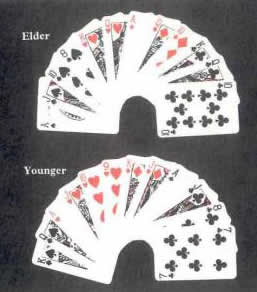THE PLAY
After the non-dealer has counted his poker hand he leads a card. The dealer then counts his hand and plays a card to the non-dealer’s lead. Two cards constitute a trick, and it is compulsory for the second player to follow suit to the led card if he can do so.
If not he may play any card he chooses, because there is no trump suit. They player who leads to a trick scores one point, and if his opponent wins it he scores one point for doing so (except in the case of the last trick, when he scores two points) and leads to the next trick, scoring one point for the lead.
After all 12 tricks have been played, the player who has won most tricks 10 points for having done so (Ten for the Cards, as it is called). There is no score to either player if they win six tricks each.
There are four extraordinary scores: carte blanche. If a player is dealt a hand that contains no court card he may claim carte blanche and score 10 points. It takes precedence over any other scoring combination, but the player must announce his carte blanche as soon as he picks up the poker cards dealt to him, and he must show his hand, though he need not do so until after his opponent has discarded.
Pique. If a player scores in hand and plays 30 points for it. only the non-dealer can win a pique and scores 30 points for it. Only the non-dealer can win a pique, because he scores one point for the first lead before the dealer counts his hand; this, of course, automatically rules out the dealer from scoring for a pique
Repique. If a player scores in hand alone a total of 30 points, before his opponent scores anything, he wins a repique and scores 60 points for it. Either player may score for a repique, because points in hand are counted in priority to those won in play.
Capot. If a player wins all 12 poker tricks he wins a capot and scores 40 points, not 10, for the cards. The capot, however, is not counted towards a pique because the points are not scored until the hand has been played.
The players deal alternately, and a parties (game) consists of six deals (three deals each). At the end of the parties the player with the higher score deducts from his score that of his opponent, and adds 100 points to the result.
If, however, one player fails to score 100 points, he is rubiconed, and the player with the higher score adds the two scores together, and a further 100 points. If the score after six deals is equal, each player has one more deal, and if the score still remains equal the partie is a draw.
Most card games are played in silence. Piquet is a continuous dialogue. When a player counts his hand he declares his point, sequences, quatorzes and trios, and his opponent confirms whether they are ‘Good’, ‘Not good’ or ‘Equal ‘, and , if equal, if the player announces the pip total which his opponent declares ‘Good’, ‘Not good’ or ‘Equal’. Then, during the play of the hand, the two players announce their scores as each trick is played.

At piquet it is customary to call the non-dealer the elder (hand) and the dealer the younger (hand). The deal above (after both players have discarded) illustrates the method of scoring and is not to be accepted as an example of good play.
